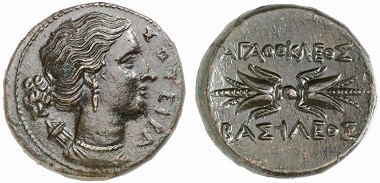Sicilian Mosaic Part 10: Rescue by the Mother City of Corinth
translated by Sylvia Karges
In 354 Dion was murdered. For many he was the embodiment of the Platonic ideal of a philosopher on the throne. His followers sent for support to Corinth, where many years ago the founders of Syracuse had come from. And the Corinthians were willing to help. They sent a small army under Timoleon.
Timoleon from a work of Guillaume Rouille from 1553. Source: Wikipedia.
Timoleon, 344-337/6
Until then, Timoleon was a blank slate. He wasn’t that young anymore, and without any large successes. But there was one dark spot in his past: He had killed his brother. Within only six years, however, he was able to conquer Sicily, supported by his small army.
The first one to surrender was the ruling tyrant Dionysius II. He was allowed to live a private life in Corinth. After that, Timoleon crushed the Carthaginians and negotiated a lasting peace.
Timoleon’s conquest explains the adaption of Corinthian coin types in Syracuse. – Syracuse. Didrachm, 344-317. From Gorny & Mosch Auction 237 (2016), 1170.
In contrast to the previous tyrants, Timoleon tried to create a lasting political and economic structure on Sicily, which would also function in his absence. To this end, he deprived many smaller tyrants of their power, ordered numerous castles to be destroyed so they would not be used for protection by tyrants, and had the old democratic constitution of Syracuse newly revised. In order to revive Sicily’s economic power, he brought settlers over from Italy and gave them land. A flourishing economy rewarded these efforts.
But in 337/6, when the now old and fully blind Timoleon stepped down, the old power struggles set in immediately with a new intensity.
Agathocles kisses the widow of his patron Damas, who would become his first wife. Source: Wikipedia.
Agathocles, 317-289
The unrest lasted 20 years. Agathocles, the son of a potterer, became its beneficiary. As a sort of condottiero, a leader of mercenaries, he developed a reputation as the defender of the ordinary people against the upper class. In 317, after a coup, it was this reputation which brought him to power. According to Diodorus Siculus, more than 4000 people lost their lives, “who one only accused of being of better birth than the others.”
The ordinary people loved Agathocles. They were the ones he could rely on in order to re-establish the Syracusan hegemony. He fought a war lasting more than 10 years, first against the Greek cities, then against Carthage, which led him and his expedition army all the way to Africa.
But Syracuse wasn’t able to permanently withstand powerful Carthage, which is why Agathocles had to plea for peace, which was gladly given to him. In 305 he entered into a treaty with Carthage, after which all of Sicily’s non-Carthage ruled areas peacefully fell into his hands.
Syracuse. Agathocles. Bronze, ca. 305-295. From Gorny & Mosch Auction 208 (2012), 1164.
Meanwhile, new times had arrived in Greece. The era of the powerful city states was over, once and for all. Alexander the Great had conquered half the world and after his death major rulers divided the empire amongst each other. They had introduced hereditary monarchies and based their right of rule on their personal positions of power. The title “Basileus” and the royal diadem became hallmarks of this position, separating the Hellenistic sole ruler from the Greek tyrant.
Agathocles assimilated into this new world. He took the title of Basileus and looked for blood relationships to other Hellenistic princes: He married his daughter to King Pyrrhus, and he himself took the daughter of Ptolemy I of Egypt as his third wife.
In 289 Agathocles was murdered. Palace intrigues regarding the line of succession were presumed to be the reason. His death caused a power vacuum, which was first filled by Pyrrhus who attempted to create a Great Empire in Italy and Sicily and then, later, by the Romans.
In the following parts of this series, we will show you coins which were minted in classical Sicily, and we will talk about their motifs, starting with Syracuse.
This article was originally published in MünzenRevue 4/1997.
Please find all parts of this series in our archives.
If you are interested in Sicily, you should certainly check out the numismatic diary “Sicily in full bloom”. Find this series also in our archives.









